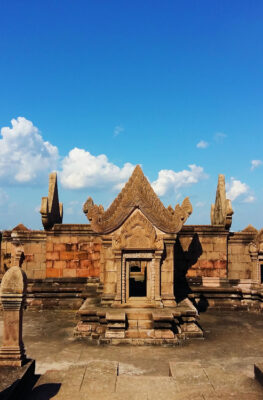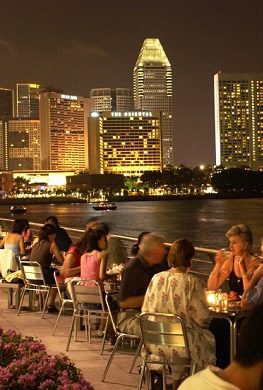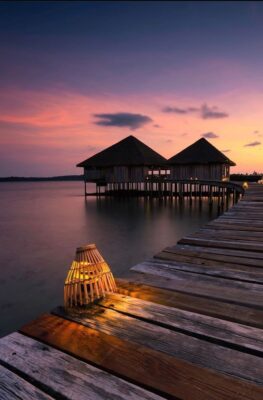Published on December 9, 2009
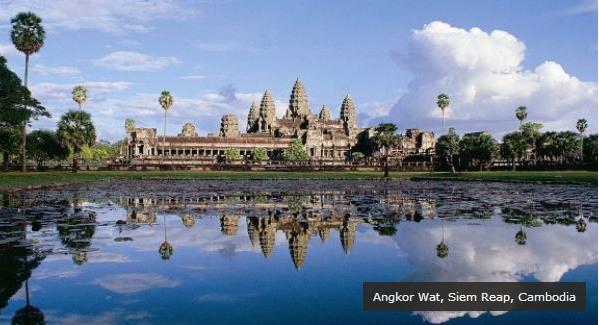
As I explored the remains at Cambodia’s Angkor Archaeological Park I couldn’t help but feel a bit humbled. Seeing first-hand the extent of humanity’s ingenuity and capability, the effect is beyond inspirational. This place is so inspiring and full of mystery, I honestly felt privileged to walk in the footsteps of the ancient Khmer civilization that built it.
The best way experience ancient Angkor is to hire a driver and guide and we were very lucky in this department. While many destinations in Southeast Asia are notorious for their unscrupulous taxi louts, the pair we met were fantastic. The daily price – $10 USD for the driver and an additional $10 USD for the guide turned out to be the bargain of the century.
After purchasing a multi-day pass we headed to the entrance of Angkor Thom, a fortified city marked with five monumental gates serving as entrances into an ancient Khmer past. When exploring the temples of Angkor, there are a few things that become quickly overwhelming: the heat and humidity, the sheer amount of tourists, and the impoverished children that swarm around you selling maps, postcards and other trinkets.
To get us started, our guide (Heng) gave us a brief overview and named the important temples and monuments behind Angkor Thom’s walls including; Bayon, Baphuon, the Terrace of the Elephants and the Terrace of the Leper King.
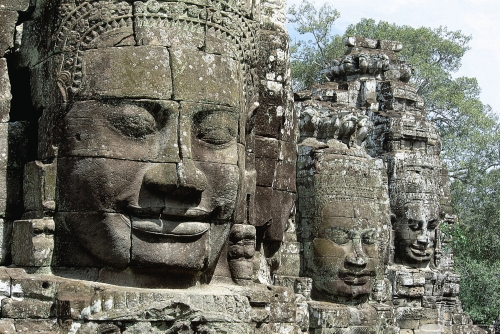
Bayon was by far the most impressive and memorable, in part because it feels as if you are being watched from every angle as you explore the temple. Heng explained the majestic temple is adorned with 216 smiling faces of King Jayavarman VII, who commissioned its creation around the year 1200. Almost as impressive are the seemingly endless reliefs depicting historical events and scenes from everyday life that adorn the walls of the temple. Walking amongst there shadows, I couldn’t help imagine how magnificent this temple must have been in its heyday, especially considering how mind-blowing the ruins are today.

Ta Phrom is an eerie place that exudes atmosphere and it is no wonder hot-shot Hollywood producers chose the location for “Tomb Raider” starring Angelina Jolie. Set deep in the heart of the jungle, most of this temple’s buildings have either been knocked over or are dominated by massive silk cotton trees, whose roots strangle the stone walls like tentacles. Any adventurer or archeologist would feel right at home here. As much as I enjoyed Ta Phrom, I was anxious to get to the main event.
Approaching Angkor Wat, the first thing that sticks out (besides the immense size) is the surrounding moat, which some believe is based on the oceans of the world (water is important in Khmer beliefs for its contributions to life and purification). Crossing the moat, I became more and more anxious to take it all in. Each step I took toward the main complex came with a small jolt of adrenaline.While most other temples in the park have succumbed to the elements, Angkor Wat remains surprisingly well-preserved and intact, especially considering it is approximately 900 years old. For this reason, it is considered the crown jewel of the region. It is also the third largest religious building in the world (some reports claiming it is indeed the largest). I was blown away by both the immense size and the tiny details that confronted me with every turn.
Inside the surrounding moat are five mountain-like towers shooting up towards the heavens (symbolizing Mount Meru of Hindu mythology). The architecture itself is an astounding example of symmetry and design. Our guide explained the temple faces west, supporting the theory it was constructed both as a mausoleum for Suryavarman II and as a tribute to the Hindu god Vishnu (west is the direction associated with both death and this particular Hindu deity). I could not get enough of this place – even the steep steps to the third level (55 meters above the ground) didn’t bother me – any moment of fatigue was replaced with awe-inspired adrenaline as I contemplated how amazing this place really was and the ingenuity and effort required for its creation. We took our time and studied every miniscule feature of the temple. Angkor Wat was built to command attention, a fact that hasn’t changed in over 900 years.
Later, we had Heng and our driver take us exploring outside Siem Reap and the main Angkor complex. One highlight was Banteay Srey, located 30 km away. At first glance, it appears a bit small, as will anything when compared to the temples of Angkor. But I couldn’t help be impressed by its inherent beauty and vibrant walls made of pink sandstone. Further still was Beng Mealea and its strange, abandoned aura. What was once a majestic structure is now no more than piles of bricks. But this is part of it charm (that and the fact that the land surrounding it was infested with land mines until very recently).
To really experience Angkor Wat, set aside at least three days to explore. Since the entire area stretches over 400 km2, you’ll really just scratch the surface, but it’s a good start for those who want an intoxicatingly potent mix of history, adventure and mystique.
Matt Totsky is a recovering advertising copywriter. Since leaving his native Detroit, he has lived in places like Bangkok and London while endlessly pursuing his next freelance writing assignment.



